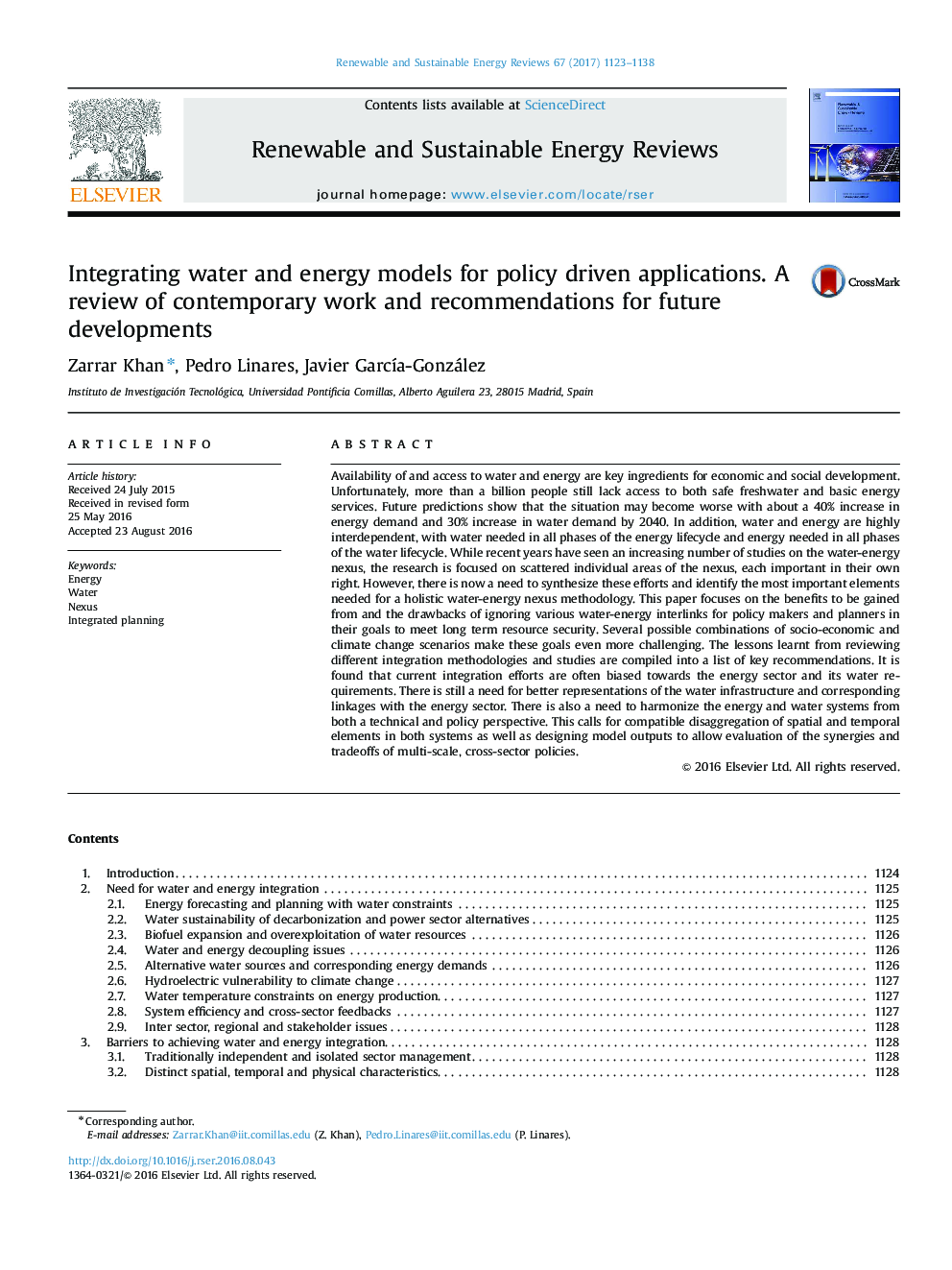| کد مقاله | کد نشریه | سال انتشار | مقاله انگلیسی | نسخه تمام متن |
|---|---|---|---|---|
| 5482792 | 1522318 | 2017 | 16 صفحه PDF | دانلود رایگان |
عنوان انگلیسی مقاله ISI
Integrating water and energy models for policy driven applications. A review of contemporary work and recommendations for future developments
ترجمه فارسی عنوان
ادغام مدل های آب و انرژی برای برنامه های کاربردی مبتنی بر سیاست. بررسی کار معاصر و پیشنهادات برای تحولات آینده
دانلود مقاله + سفارش ترجمه
دانلود مقاله ISI انگلیسی
رایگان برای ایرانیان
ترجمه چکیده
دسترسی و دسترسی به آب و انرژی، عوامل کلیدی برای توسعه اقتصادی و اجتماعی است. متأسفانه بیش از یک میلیارد نفر هنوز دسترسی به منابع آب آشامیدنی و خدمات پایه انرژی ندارند. پیش بینی های آینده نشان می دهد که وضعیت با 40 درصد افزایش تقاضای انرژی و افزایش 30 درصدی تقاضای آب تا سال 2040 می تواند وضعیت را بدتر کند. علاوه بر این، آب و انرژی به شدت وابسته به یکدیگر هستند و آب مورد نیاز در تمام مراحل چرخه عمر انرژی و انرژی مورد نیاز در تمام مراحل چرخه زندگی آب است. در حالی که سال های اخیر شمار بیشتری از مطالعات مربوط به رابطه آب و انرژی را مشاهده کرده اند، این تحقیق بر روی مناطق فردی پراکنده در ارتباط است که هر کدام از آنها مهم است. با این حال، در حال حاضر نیاز به ترکیب این تلاش ها و شناسایی مهم ترین عناصر مورد نیاز برای روش یکپارچه آب و انرژی ارتباطات وجود دارد. این مقاله بر مزایایی است که از نقاط ضعف و ناکارآمدی پیوندهای مختلف آب و انرژی برای سیاست گذاران و برنامه ریزان در دستیابی به اهداف خود برای تامین امنیت درازمدت بهره می گیرد. چندین ترکیب احتمالی سناریوهای اجتماعی-اقتصادی و تغییرات آب و هوایی این اهداف را به چالش کشیدند. درس هایی که از بررسی روش های مختلف ادغام و مطالعات آموخته شده یاد می شود به لیستی از توصیه های کلیدی گردآوری شده است. مشخص شده است که اغلب تلاش های ادغام شده اغلب به سمت بخش انرژی و نیازهای آب آن متمرکز است. همچنان نیاز به نمایندگی بهتر از زیرساخت های آب و ارتباطات مربوطه با بخش انرژی وجود دارد. همچنین نیاز به هماهنگی سیستم های انرژی و آب از دیدگاه فنی و سیاستی وجود دارد. این امر برای جداسازی سازگار از عناصر فضایی و زمانی در هر دو سیستم و نیز طراحی خروجی های مدل به منظور ارزیابی هم افزایی و توفیق های سیاست های چندسطحی و متقابل بخش های مختلف نیاز دارد.
موضوعات مرتبط
مهندسی و علوم پایه
مهندسی انرژی
انرژی های تجدید پذیر، توسعه پایدار و محیط زیست
چکیده انگلیسی
Availability of and access to water and energy are key ingredients for economic and social development. Unfortunately, more than a billion people still lack access to both safe freshwater and basic energy services. Future predictions show that the situation may become worse with about a 40% increase in energy demand and 30% increase in water demand by 2040. In addition, water and energy are highly interdependent, with water needed in all phases of the energy lifecycle and energy needed in all phases of the water lifecycle. While recent years have seen an increasing number of studies on the water-energy nexus, the research is focused on scattered individual areas of the nexus, each important in their own right. However, there is now a need to synthesize these efforts and identify the most important elements needed for a holistic water-energy nexus methodology. This paper focuses on the benefits to be gained from and the drawbacks of ignoring various water-energy interlinks for policy makers and planners in their goals to meet long term resource security. Several possible combinations of socio-economic and climate change scenarios make these goals even more challenging. The lessons learnt from reviewing different integration methodologies and studies are compiled into a list of key recommendations. It is found that current integration efforts are often biased towards the energy sector and its water requirements. There is still a need for better representations of the water infrastructure and corresponding linkages with the energy sector. There is also a need to harmonize the energy and water systems from both a technical and policy perspective. This calls for compatible disaggregation of spatial and temporal elements in both systems as well as designing model outputs to allow evaluation of the synergies and tradeoffs of multi-scale, cross-sector policies.
ناشر
Database: Elsevier - ScienceDirect (ساینس دایرکت)
Journal: Renewable and Sustainable Energy Reviews - Volume 67, January 2017, Pages 1123-1138
Journal: Renewable and Sustainable Energy Reviews - Volume 67, January 2017, Pages 1123-1138
نویسندگان
Zarrar Khan, Pedro Linares, Javier GarcÃa-González,
